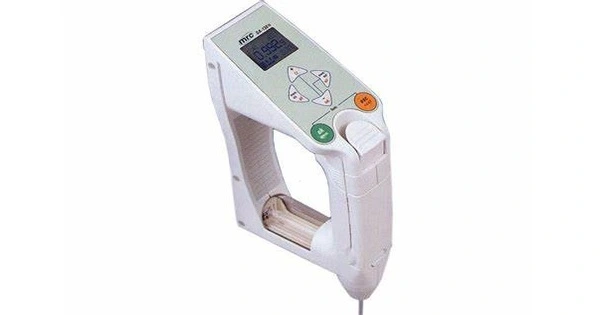A gravitic density meter is a type of density meter that is used in a variety of sectors to determine the density of a slurry running through a pipeline. It is made of a flexible rubber tube that deflects when weight flows through it. A displacement measurement device, such as a high-precision laser or load cell, is used to determine how much change has occurred in the system. A gravitic density meter can be used to calculate the change in deflection of the hose in real-time, allowing for continuous density measurement.
Gravitic density meters do not measure specific gravity directly. The specific gravity is calculated after the density has been determined.
Components
A gravitic density meter consists of several components. Temperature data are acquired using a resistance temperature detector (RTD). These measurements are used to adjust for temperature. A pressure transducer is used to measure pressure changes. Pressure influences the rigidity of a flexible hose. Changes in stiffness affect how the flexible hose deflects. The flexible hose is used to determine deflection. Larger weights generate greater deflection in the flexible rubber hose. The flexible hose should be repeatable, accurate, and precise. It is impossible to achieve an accurate measurement without these three properties.
Insulation is utilized to protect the flexible cartridge and isolate it from the effects of the ambient temperature. When the ambient and media temperatures change significantly, the flexible cartridge behaves differently than usual. The displacement measuring instrument must have a quick response time. A quick response generates additional data, which can be utilized to compensate for vibration. Gravitic density meters determine the total volume within the flexible cartridge. This leads to an extremely high sample size. Because the full sample will pass through the pipe, measurements will be taken that reflect the whole sample.
Industries
Gravitic density meters have many uses in many different industries. Mining, dredging, wastewater, paper, and oil and gas all make use of gravitic density meters. All these industries need to measure the amount of solids moving through its respective process.
- These are used in the mining industry to determine how much ore is being transported.
- These are used in the dredging industry to measure the amount of trash that the dredge moves and carries.
- These are used in the wastewater industry to determine how much sewage needs to be treated.
- These are used in paper production to measure the amount of pulp being used at any one time.
- These are used to measure the amount of oil and gas in a system. Because oil and gas are lighter than water, this scenario demonstrates gravitic density meters’ adaptability.
















